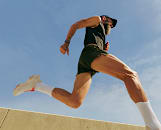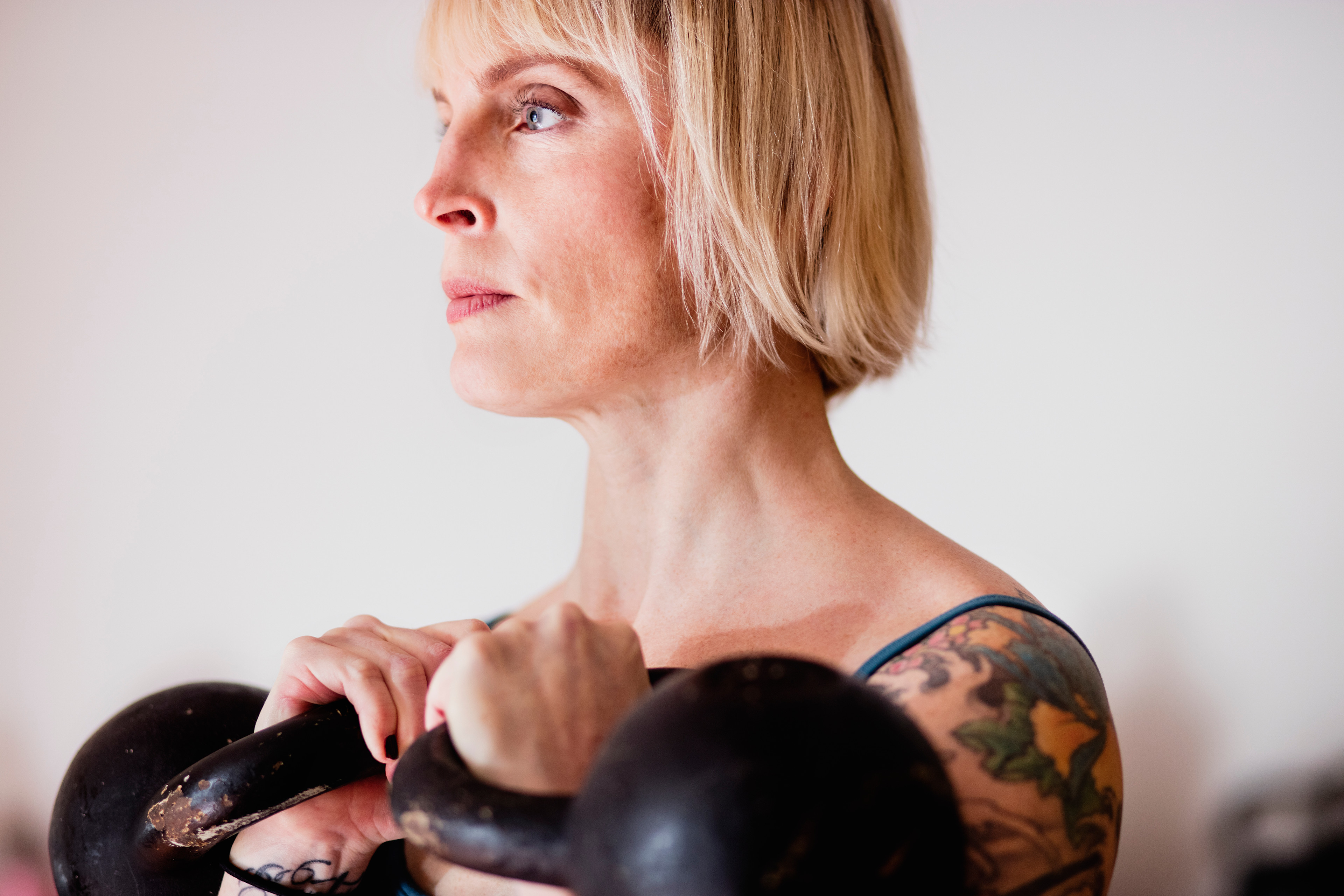
Ron Levine via Getty Images
9 Kettlebell Exercises That Build Shoulders of Steel
These versatile free weights offer strength and stability benefits that dumbbells just don’t.
By Jordan Smith•
Which Muscles Do Kettlebell Shoulder Exercises Work?
The Benefits of Using a Kettlebell for Shoulder Exercises
9 Kettlebell Shoulder Exercises to Try
Tips to Keep In Mind When Using Kettlebells for Shoulder Exercises
How to Add Kettlebell Shoulder Exercises to Your Routine
The Takeaway
If you want to build shoulder strength, you might imagine spending a lot of time at the weight rack or figuring out how to fit a bunch of strength equipment in your home gym. But hear us out—you can build strong shoulders with one key piece of equipment: the kettlebell.
Discover more ways to reach your goals with Peloton
You might be familiar with the most common move done with this piece of equipment—a kettlebell swing—but the kettlebell is much more versatile than that. If you’re looking to build strong, stable shoulders, for example, there are plenty of kettlebell shoulder exercises that can help you get there.
Ahead, Peloton instructor Jess Sims breaks down why kettlebells are so effective for building shoulder strength, how to add her favorite kettlebell shoulder exercises to your routine, and form tips for executing them with flawless form.
Which Muscles Do Kettlebell Shoulder Exercises Work?
In the context of strength training, you might think of your shoulders as just the topmost outer section of your upper arms, but the shoulder is so much more than that; it’s widely considered the most complex joint in the human body, with three bones, almost a dozen different muscles, and many ligaments and tendons involved.
When performing kettlebell exercises specifically for the shoulders, you’re targeting large primary movers as well as smaller stabilizer muscles, explains Peter Schultz, physical therapist and founder of Dynamic Sports Physical Therapy. Some of the primary muscles targeted include:
Deltoids: The triangular-shaped muscles that form the rounded outside section of your shoulder at the very upper part of your arm. They help stabilize your shoulders to prevent injury and assist with movements such as raising your arms.
Pectorals: Also known as the pecs, these are the chest muscles that stretch from your armpits to your sternum. The pecs help stabilize and move the shoulders.
Latissimus Dorsi: Commonly referred to as the lats, these are a pair of large, triangular-shaped muscles that stretch across your back from your armpit to your lower back. They help stabilize your spine and support shoulder blade movement.
The smaller stabilizing muscles you’re working when doing a kettlebell shoulder workout include:
Rotator Cuff: The rotator cuff isn’t a single muscle but a group of four muscles (the supraspinatus, infraspinatus, teres minor, and subscapularis) and their tendons that surround the shoulder joint, helping to stabilize it and allowing for its large range of motion.
Rhomboids: The rhomboids are small rhomboid-shaped muscles that sit on either side of your spine in your upper back, and stretch over to the inside edge of your shoulder blades. Their main function is to move your shoulder blades.
Middle and Lower Trapezius: The trapezius muscles, better known as your traps, stretch from the base of your skull to the top of your shoulder blades and then down your spine to your mid-back. Many kettlebell shoulder exercises work the middle and lower sections of your traps, as those parts of the muscles work to stabilize and move your shoulder blades.
In addition to all the above, many kettlebell shoulder exercises will also tap into small muscles that control spinal movements, as well as your core, which works to stabilize your body whether you’re holding a weight on one side or hinging forward to row.

Peloton App
Access thousands of classes with no equipment needed.
The Benefits of Using a Kettlebell for Shoulder Exercises
One of the main perks of using a kettlebell for shoulder exercises is its versatility. You can use kettlebells for classic, strength-building shoulder isolation exercises (think: overhead presses), but they’re also fantastic for shoulder stability work. Having strong, stable shoulders allows your muscles and joints to function properly and reduces the risk for injuries such as shoulder impingement or biceps or rotator cuff tendonitis, according to the American Council on Exercise.
Traditional kettlebell moves like windmills, Turkish get-ups, and carries all help drill shoulder stability, which can help you move more efficiently through workouts, sports, and life. “Overhead athletes or anyone who performs overhead activities, from lifting luggage to an overhead compartment to putting dishes away, requires a lot of stability and specific timing of muscles in the shoulder,” Schultz explains.
What’s more, the shape of the kettlebell requires you to use more stabilizing muscles than machines or even dumbbells. “Kettlebell weight distribution allows your shoulders to work in different ways to stabilize the bell,” Jess says. For example, a 2022 study published in Sensors found that overhead pressing with a kettlebell activates shoulder muscles more effectively than with dumbbells, due to the location of the kettlebell's center of gravity.
Additionally, the handle of the kettlebell requires you to work your grip strength, which may play a role in preventing shoulder injury. According to a 2016 study published in Shoulder and Elbow, stronger grip strength is correlated with stronger lateral rotator muscles, which researchers say can serve as an indicator of rotator cuff function.
9 Kettlebell Shoulder Exercises to Try
There are plenty of kettlebell shoulder exercises you can incorporate into your routine depending on your training goals. These moves, which Jess says you can program into your workouts similar to how you would incorporate dumbbell shoulder exercises, are a great place to start.
1. Kettlebell Bottoms-Up Press
“One of my favorite kettlebell shoulder exercises is a bottoms-up press, where you hold the handle and the bell portion is toward the ceiling,” Jess says. This move helps you work on shoulder stabilization, since you have to work to hold the bell steady as you press it overhead. Because this move requires so much balance and stability, opt for a lighter weight than you’d typically pick up for a dumbbell overhead press.
Start seated (for beginners) or standing with feet shoulder-width distance apart. Hold the kettlebell in your right hand, racked near your shoulder with the bell facing up (the bottom of the bell pointing toward the ceiling) and right elbow close to your body.
Engage your core and keep a straight wrist as you straighten your arm to press the bell overhead, keeping the working arm close to your ear.
Pause at the top, then bend your elbow to lower the bell back down to the starting position. That’s one rep.
Repeat for the desired number of reps, then repeat on the other side.
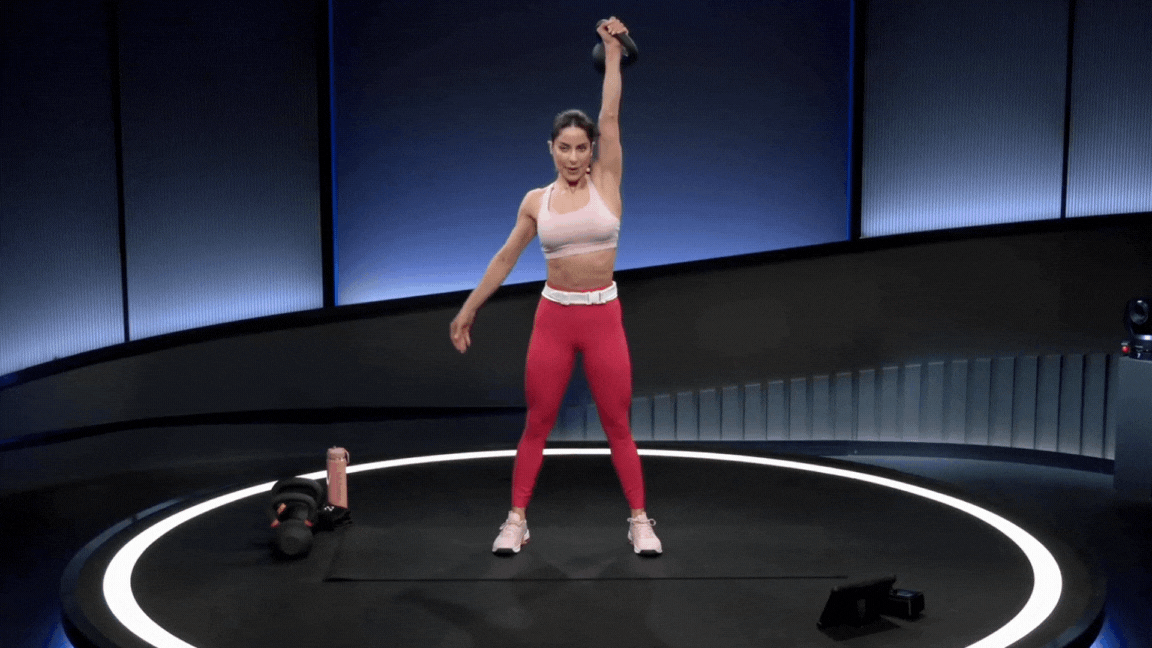
2. Kettlebell Push Press
You can go a bit heavier with your kettlebell for a push press, since it’s an explosive movement that recruits the legs, Jess says. Note: If you have two kettlebells of the same weight, you can do the kettlebell push press with one in each hand for a bonus challenge. Kettlebell beginners can modify the move by holding one kettlebell in the center of their chest, with a hand gripping either side of the handle.
Stand with feet shoulder-width distance apart, holding a kettlebell in one hand, racked in front of your shoulder, with the handle of the bell pointing up and the ball resting on the outside of your forearm.
Bend your knees slightly, then explode upward to push the weight overhead, straightening your arms and legs simultaneously. Use the momentum from your legs to help press the kettlebell overhead.
Bend your knees and lower the kettlebell back to shoulder height to return to the starting position. That’s one rep.
Repeat for the desired number of reps, then repeat on the other side.
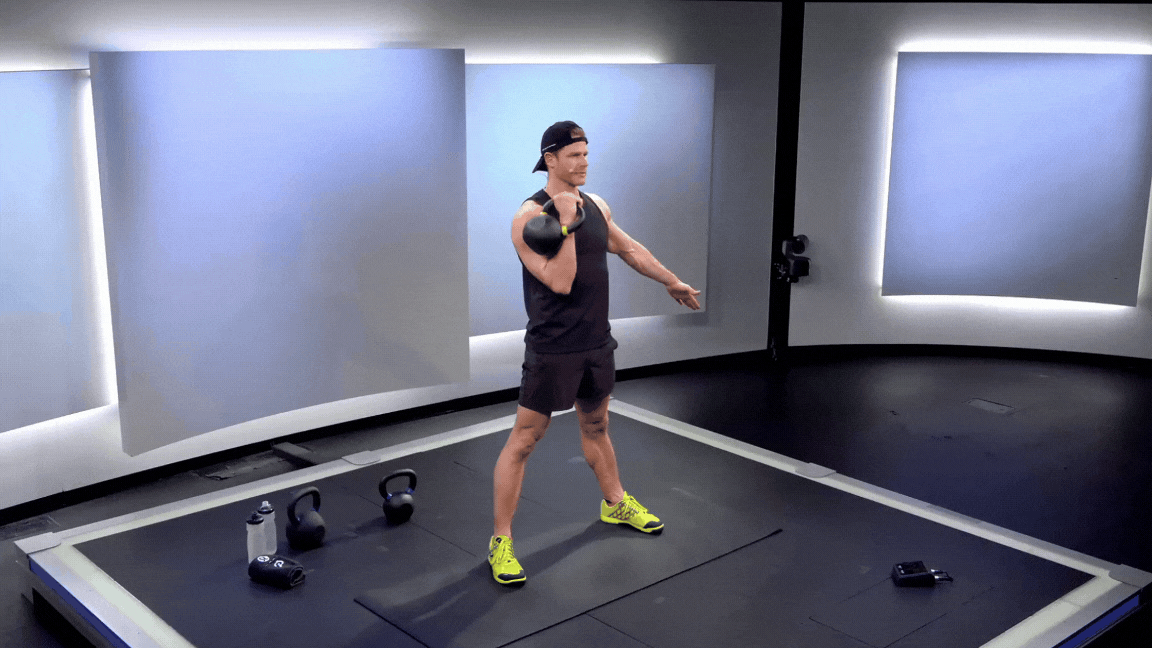
3. Kettlebell Strict Press
If you’re looking for a move that isolates the shoulder muscles, the strict press is it, Jess says. The strict press, also known as an overhead press or a shoulder press, builds shoulder strength and helps support functional movements like reaching overhead to place items on a high shelf.
Start standing with feet shoulder-width distance apart. For additional stability, stand with one foot slightly in front of the other.
Hold a kettlebell in one hand in front of your shoulder with the handle of the bell pointing up and the ball resting on the outside of your forearm. Keep your elbow close to your body.
Brace your core and press your arm straight overhead.
Bend your elbow to lower the kettlebell back to the starting position. Complete the desired number of reps, then repeat on the other side.
4. Kettlebell Offset Push-Up
“The offset stance of the hands in this push-up variation affects the chest and shoulders differently than a traditional push-up, therefore providing a new challenge,” Jess says.
Start in a high plank position with hands under shoulders and feet shoulder-width distance apart. Place a kettlebell on the floor, lying on its side, under your right shoulder. Rest your right hand on the bell so you are slightly elevated on one side in an offset position.
Brace your core and bend your elbows to lower your chest toward the ground, maintaining a flat back. Lower as far as you can while keeping your body in a straight line.
Pause at the bottom. Then, press through your palms to straighten your arms, returning to the starting position. That’s one rep.
Complete your chosen number of reps with one hand elevated on the kettlebell, then switch and repeat on the other side.
5. Kettlebell Half-Kneeling Halo
A half-kneeling halo focuses on core stability, balance, and shoulder range of motion, according to Schultz. This move can be used as a shoulder warm-up, as it works a full range of motion in your joints.
Start in a half-kneeling position, with your left knee on the floor under your left hip, and right foot planted on the floor in front of you with the right knee bent at 90 degrees.
Hold the kettlebell in front of your chest with one hand on each corner of the handle and the bottom of the bell facing up.
Keep your wrists straight and core engaged as you circle the kettlebell around your head: move the kettlebell toward your right shoulder, behind your head, and around your left shoulder to return to the starting position.
Continue for the desired number of reps. Then repeat, rotating in the opposite direction.
6. Kettlebell Waiter’s Carry
This overhead carry movement helps to build shoulder stability, Schultz says.
Start with feet shoulder-width distance apart, holding the kettlebell at shoulder height, bottom of the bell pointing up, in one hand.
With a tight grip on the kettlebell and elbow pinned near your rib cage, walk forward for a chosen distance (i.e., 10 steps).
Turn around and walk back to where you started. That’s one rep. Repeat for the desired number of reps, alternating arms.
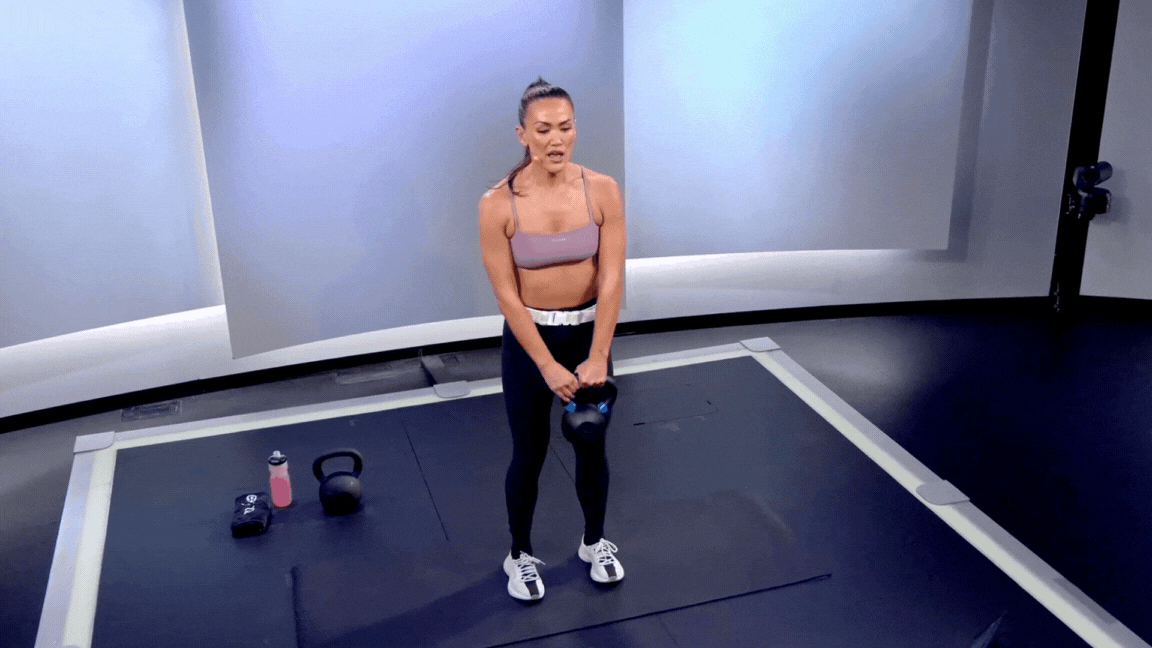
7. Kettlebell Around the World
This move is great for focusing on both core stability and the range of motion in your shoulder, according to Schultz.
Start standing with your feet shoulder-width distance apart, holding a kettlebell in your right hand at your side with your arm slightly bent.
In a slow, controlled motion, rotate the kettlebell in a counter-clockwise motion, crossing it in front of your body and switching it to your left hand. The kettlebell should be about thigh height.
Continue the rotation behind your body, switching the kettlebell back to the right hand when it crosses the back of your body.
Continue for the desired number of reps. Then repeat in the opposite direction,
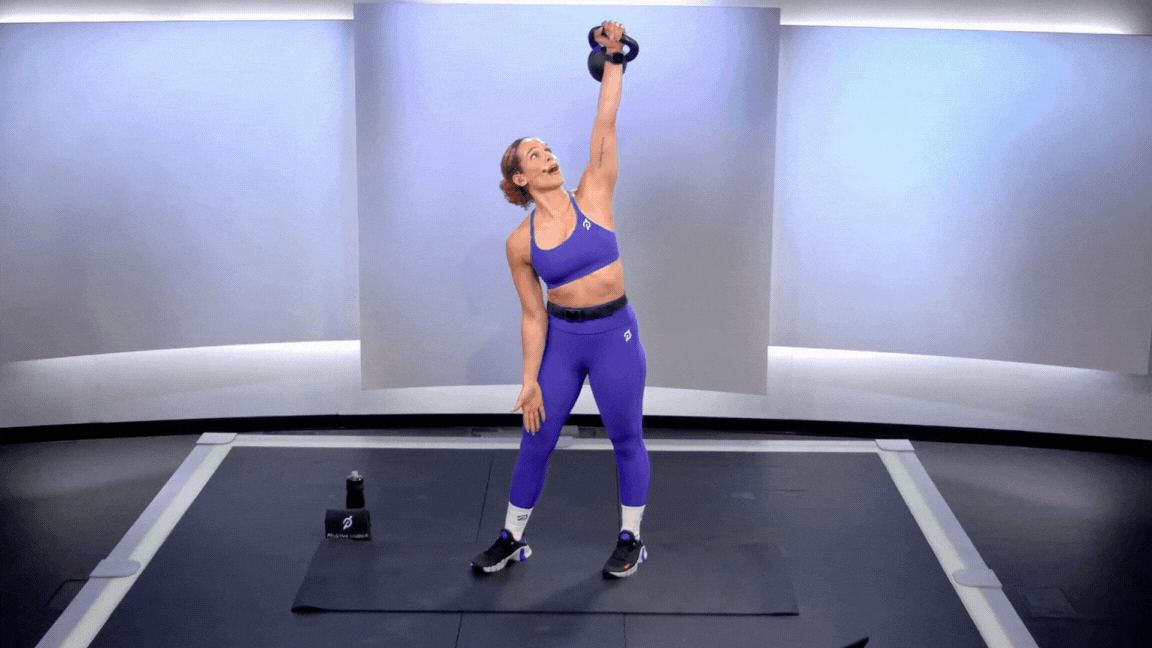
8. Kettlebell Windmill
The kettlebell windmill helps with stability and mobility in the shoulder girdle (the collarbone and scapula), which helps move your arms.
Start standing with feet shoulder-width distance apart or slightly wider, holding a kettlebell in your right hand extended overhead so it’s stacked directly over your shoulder. Point your left toes out slightly.
While looking up at the kettlebell, slide your left hand down the inside of the left leg as you sink back into your hips, allowing both knees to bend slightly and rotating your chest so the kettlebell is stacked directly over both shoulders. Lower until your hand reaches the floor, or until you feel a stretch in your left hamstring.
With control, lift your torso and push your hips forward to return to the starting position.
Repeat for the desired number of reps, then repeat on the other side.
9. Kettlebell Turkish Get-Up
The Turkish get-up is a full-body exercise that focuses on shoulder stability, Schultz says. Fair warning, this move can be complicated to master at first. (Our Turkish get-up guide provides an in-depth explainer on the benefits and exactly how to do this dynamic move.)
Lie face up on the floor with a kettlebell just outside your left shoulder, with your legs extended and slightly separated. Bend your left knee, placing your left foot flat on the floor. Grab the handle of the bell with your left hand and press the kettlebell over your chest. Extend your right arm out to the side diagonally, with your palm pressed into the floor.
Prop up your torso by pushing into your left foot and rolling onto your right forearm. Keep your left arm in a fully locked position and your eyes on the kettlebell with your shoulder blades packed back and down.
Brace your core and push up to your right hand to sit tall with your back straight. Keep your left arm fully locked out over your shoulder and eyes on the kettlebell.
Press into your left foot and raise your hips into a bridge position with your right leg extended. Then, thread your right leg under your body to place your knee on the floor.
Keeping the kettlebell stacked over your left shoulder, lift your right hand off the floor into a half-kneeling position.
Rotate and square your hips forward, then slowly stand up.
Reverse these steps to return to the starting position. Repeat for the desired number of reps, then repeat on the other side.
Tips to Keep In Mind When Using Kettlebells for Shoulder Exercises
If you’re new to using kettlebells, there can be a bit of a learning curve. You should take it slow and reach for a weight you may consider light compared to other upper body workouts. “Definitely use a lighter weight than you normally would with other shoulder exercises because [kettlebells] require a lot more balance and stability,” Jess says.
Don’t hesitate to modify as necessary. While some of the kettlebell shoulder exercises above must be done one-handed, some can be performed holding a single kettlebell in two hands to reduce the difficulty and help ease you into your training.
And though there are specific form considerations to focus on depending on which exercise you’re doing, there are a few key form cues you should always keep in mind:
Maintain a Strong Wrist: In all kettlebell shoulder exercises, you should maintain a strong wrist, meaning there’s no bend; the back of your wrist and forearm should form a straight line.
Start with a Sold Rack Position: In a rack position (when you’re holding a single bell in front of your shoulder), make sure to keep the elbow, wrist, and knuckles in one line, Jess says. Keep your elbow in tight next to your ribs.
Engage Your Core: When doing any overhead kettlebell moves, remember to keep your core engaged. Don’t let your back arch or ribs flare open; think about drawing the bottom of your front ribs gently toward your hip bones. In moves like windmills or Turkish get-ups, where you need to maintain a strong trunk in different positions and in motion, keeping your core in mind is even more important.
How to Add Kettlebell Shoulder Exercises to Your Routine
If you have general strength goals, you can program kettlebell exercises into your training just like you would when doing dumbbell strength work, Jess says. That could mean you tap them during full-body strength workout days, use them in an upper body workout, or during a push day if you follow a push-pull workout split. You can swap entire dumbbell strength workouts for ones using kettlebells, or simply incorporate a few key kettlebell shoulder moves into your routine.
For general fitness, kettlebell shoulder exercises can be used to break the monotony of traditional exercises, Schultz says. Keep in mind that the Physical Activity Guidelines for Americans currently recommends that adults include 150 minutes of moderate-intensity exercise and at least two days of strength training per week. One effective way to support strength and overall fitness is by incorporating just 10- to 20-minute sessions of kettlebell training into your routine, according to a 2019 study published in the Journal of Human Kinetics.
On the Peloton App, you can find kettlebell classes that target your shoulders (and so much more) under both the strength and cardio categories.
The Takeaway
Using a kettlebell is a great way to mix up your shoulder workouts and train to get stronger for your other workouts and everyday life. The shape of the kettlebell introduces a unique challenge to your training, requiring you to focus on stability in a way that other free weights just don’t. To really feel that difference, try the bottoms-up kettlebell press—Jess’s personal favorite way to use kettlebells for shoulder strength.
Related Articles

Strength Train
How to Improve Your Posture—and Why It’s Important For Your Workouts

Strength Train
How to Work Your Entire Core with a Kettlebell

Stretching + Mobility
8 Upper Body Stretches to Relieve Tension In Your Shoulders, Arms, and Chest

Strength Train
Explosiveness Isn’t Just For Athletes. Boost Yours With These 6 Moves for Speed and Power
This content is for informational and educational purposes only and does not constitute individualized advice. It is not intended to replace professional medical evaluation, diagnosis, or treatment. Seek the advice of your physician for questions you may have regarding your health or a medical condition. If you are having a medical emergency, call your physician or 911 immediately.
Build full-body strength
Enter your email to get articles, instructor tips, and updates from Peloton sent to your inbox.
By providing your email address, you agree to receive marketing communications from Peloton.
For more about how we use your information, see our Privacy Policy.

